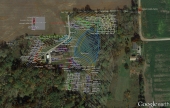Fredy Perlman wrote:I didn't think year-old trees would have developed potform yet; would you order from this nursery again? Plenty sell people rootbound trees with no compunctions.
I think there are two issues here, firstly are you a 'natural' purist, and only want a perfect 'natural' rootball, or are you more interested in the long term result? If the former, you'll need to do some kind of direct-seeding approach, but remember that even in perfect conditions there might be some factor that creates root deformation in the root system. Any nursery system is going to create an 'unnatural' root formation by the nature of the growing system, either following the shape of the pot, or root-pruning in an open field nursery. You will find that even perfect air-pruning systems can still create deformed roots.
So what I'm saying is that realistically root deformation is going to occur in every nursery to some extent. Always assume it is bad, and have a good look at every tree before you plant it. It might take you a few seconds longer, but you will never regret it. Removing fully grown dead trees in 15 years is a pain in the neck.
Yes I would have no issues buying from the same nursery again. Even the nurseries employing the best growing systems can still create bad root systems at times, I would be checking the roots anyway, sometimes there are other factors that are more important, such as nursery distance and plant cost.
It must also be said that there are times when nursery people deliberately let the roots get bad. When I am planting tender trees in inaccessible areas that require carrying through steep slopes etc, I will often let a tree get very oversized in a small container. A tree 6-8' tall in a pot 4-5" wide looks truly ridiculous, but do massive root surgery before planting, plant them deep and reduce the branch/leaf structure significantly before planting and it is a method for establishing larger grade trees in marginal or inaccessible sites where smaller plants might get frosted or lost in long grass.
Bryant Redhawks comment about the first two years is spot on, don't get discouraged if there is not much above ground growth the first year!









 2
2









 2
2




 2
2
























 1
1








